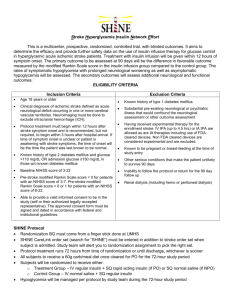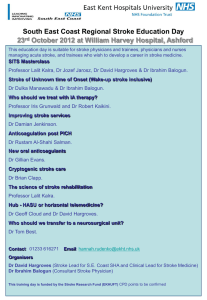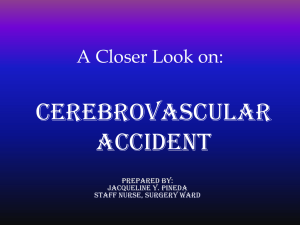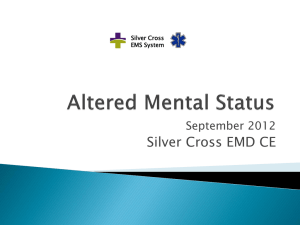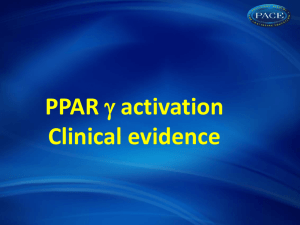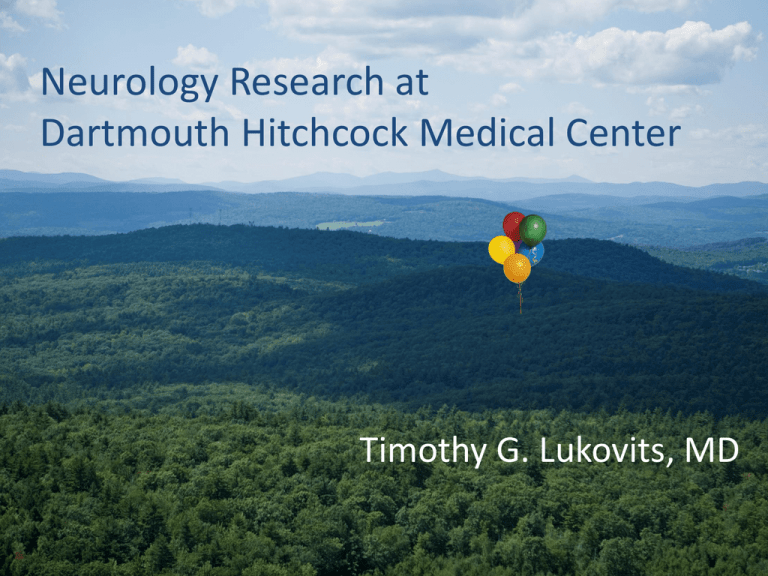
Neurology Research at
Dartmouth Hitchcock Medical Center
Timothy G. Lukovits, MD
Disclosures:
• I have no financial disclosures
• I am the local PI for the DIAS4, POINT and IRIS
trials
• I will only be discussing non-FDA approved
treatments in the setting of clinical trials
Neurology Research Overview
• More than 35 Active Clinical Trials and Research
Studies
• Full age range of participants: children through seniors
• Collaborative research effort with other departments
within the medical center as well as Dartmouth College
• 10 full and part time research coordinators
– Provide assistance with both pharmaceutical sponsored
trials as well as investigator initiated trials
– Provide Institutional Review Board management and trial
management
Epilepsy trials now enrolling
– UCB N01358 (Brivaracetam)
– Cognitive development effects of Rufinamide for
Lennox-Gastaut Syndrome
– SABRIL Vision Study
– HOBSCOTCH
UCB N01358 (Brivaracetam)
• Efficacy and Safety Study in Subjects With Partial
Onset Seizures
• Ages 16 – 80
• 1 or 2 concomitant AEDs, including VNS
• 8 Type I seizures over 8-week baseline period
• Doses of 100 and 200mg/day compared to
placebo
• Participants eligible for open-label extension
study
Adjunctive Rufinamide in
Lennox-Gastaut Syndrome
• Cognitive development effects and safety, and
pharmacokinetics of adjunctive Rufinamide in
subjects with inadequately controlled LGS.
• Ages 1 – 3
• 1 to 3 concomitant AEDs
• Randomized to adjunctive Rufinamide or any
other approved AED.
• Open label
• Primary outcome: Change in Child Behavior
Checklist (CBCL) Total Problems Score
Sabril® (Vigabatrin) Vision Study
• Structure and function of the retina in adult
patients treated with Vigabatrin
• Ages 18 and older
• Complex partial epilepsy
• 2 or more seizures/month
• At least 1 concomitant AED
• No prior exposure to Vigabatrin
• Prospective, open label
HOBSCOTCH
• HOme Based Self-management and COgnitive
Training CHanges Lives
• Ages 18 -55, confirmed diagnosis of epilepsy,
controlled or uncontrolled
• Self-reported memory complaints and low quality
of life
• Intervention 1: problem solving and
compensatory skills for cognitive dysfunction,
taught in 8 weekly sessions
• Intervention 2: Addition of BrainAge© program
(NintendoDS) for 5 weeks
Stroke/ TIA Clinical Studies now
enrolling
• Acute Stroke
– DIAS4 – Multicenter acute stroke study involving
desmoteplase in ischemic strokes
– POINT Trial – Multi-center NIH sponsored trial of
aspirin with or without Plavix in acute (less than 12
hours) minor stroke or TIA
• Secondary Stroke Prevention
– IRIS Trial – Multi-center NIH-sponsored of
pioglitazone or placebo in adult ischemic stroke
patients who do not have diabetes and are screened
for insulin resistance.
DIAS-4
– Desmoteplase is the
recombinant form of the
saliva found in the vampire
bat, desmodus rotundus
– Desmoteplase or placebo IV
1 min bolus
– 3-9 hr window
– 18-85y
– MCA, ACA, PCA stenosis or
occlusion on CTA or MRA
– 1 hr between CT and Rx
– mRS at 90days primary
outcome measure
“FLUFFY”
Our stroke team’s mascot
IRIS
Insulin Resistance
Intervention after Stroke Trial
NIH U01 NS044876
Primary Aim: To determine if reduction of insulin resistance with pioglitazone, compared
with placebo, will reduce the risk for stroke or myocardial infarction (MI) among nondiabetic patients with a recent ischemic stroke or transient ischemic attack (TIA) and
insulin resistance.
•Insulin resistance is associated with ↑ risk for atherosclerosis & clinical
vascular disease.
•The IRIS trial is based on the hypothesis that improving insulin resistance will
reduce progression of atherosclerosis and prevent recurrent stroke and MI.
•If successful, IRIS will introduce a new approach to stroke treatment.
Eligibility: Recent TIA or Ischemic Stroke
Non-diabetic
Insulin resistant
No congestive heart failure
Enrollment: Expected total = 3,936
Expected at DHMC = 40
Enrolled to date = 38
Exited at 5 years = 3
Movement Disorders trial now
enrolling
– FS-ZONE
FS-Zone
• NIH-sponsored trial of 2 doses of pioglitazone
or placebo in Parkinson’s Disease
• Age 30 years or older, with idiopathic PD of
less than 5 years duration
• Inclusion - stable dosage of Rasagiline
1mg/day or Selegiline 10 mg/day for 2 to 8
months.
• Exclusion – exposure to dopaminergic PD
therapy or amantadine
• Primary outcome: change in total UPDRS
score.
Handwriting analysis in PD - Stephen
Lee
• Observational study to characterize early
neurophysiological changes in PD
• NSF supported
• Collaboration between
• James Leiter MD, Joe Erlichman PhD
• Norconnect, Inc.
• EMG/EEG correlates during handwriting
tasks. ~ 1.5 hour long session
• Looking for patients who have not been
on medications yet, or their unaffected
spouse or friend.
Multiple Sclerosis trials now enrolling
Relapsing Remitting
– FTY 2403 (Passages)
Secondary Progressive
– ASCEND
Coming soon…
Study validating questionnaires used as a tool in
clinical studies
PASSAGE
• Safety study in patients with RRMS newly treated
with Fingolimod or other approved diseasemodifying therapies
• Long term, participants will be followed for 5
years
• Participants will start fingolimod at time of study
entry, or must have started another approved
therapy within a maximum of 6 months prior to
entry
• Exclusion – previous or current treatment with a
cytotoxic agent or natalizumab
ASCEND Trial
Objective: To investigate whether treatment with
natalizumab slows the accumulation of disability
not related to relapses in subjects with SPMS
Inclusion Criteria:
• Between 18-58 years old
• Onset of SPMS at least 2 years prior to
enrollment
• EDSS score 3.0 – 6.5 inclusive
• Disease progression independent of clinical
relapses over the past year
ALS Clinical Research
Upcoming study – November 2012
CY4026 – “BENEFIT-ALS” an oral medication being
investigated as a potential new therapy for the
improvement of muscle weakness and muscle fatigue
• Primary endpoint is the change from baseline to the
average of the ALSFRS-R total score at specific time
points
• Participation is ~ 20 weeks with one week of openlabel period
• Must have diminished, but measurable max voluntary
hand grip and able to swallow medication
• Upright slow Vital Capacity > 60% of predicted for age,
height and sex.
Thank You!
For more info: email
NeurologyResearch@hitchcock.org


